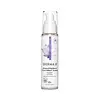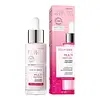What's inside
What's inside
 Key Ingredients
Key Ingredients

 Benefits
Benefits

 Concerns
Concerns

 Ingredients Side-by-side
Ingredients Side-by-side

Water
Skin ConditioningGlycerin
HumectantCamellia Sinensis Leaf Extract
AntimicrobialAcetyl Hexapeptide-8
HumectantCaprylic/Capric Triglyceride
MaskingHydroxypropyl Cyclodextrin
MaskingPalmitoyl Tripeptide-38
Skin ConditioningPanthenol
Skin ConditioningPinus Pinaster Bark Extract
AntioxidantAcacia Seyal Gum Extract
HumectantTocopheryl Acetate
AntioxidantAscorbyl Palmitate
AntioxidantEthylhexyl Palmitate
EmollientHamamelis Virginiana Water
AstringentAesculus Hippocastanum Seed Extract
Skin ConditioningChamomilla Recutita Flower
Skin ConditioningAllantoin
Skin ConditioningXanthan Gum
EmulsifyingSodium Citrate
BufferingMicrocrystalline Cellulose
AbsorbentCellulose Gum
Emulsion StabilisingPotassium Sorbate
PreservativeSodium Hydroxide
BufferingPhenoxyethanol
PreservativeEthylhexylglycerin
Skin ConditioningParfum
MaskingWater, Glycerin, Camellia Sinensis Leaf Extract, Acetyl Hexapeptide-8, Caprylic/Capric Triglyceride, Hydroxypropyl Cyclodextrin, Palmitoyl Tripeptide-38, Panthenol, Pinus Pinaster Bark Extract, Acacia Seyal Gum Extract, Tocopheryl Acetate, Ascorbyl Palmitate, Ethylhexyl Palmitate, Hamamelis Virginiana Water, Aesculus Hippocastanum Seed Extract, Chamomilla Recutita Flower, Allantoin, Xanthan Gum, Sodium Citrate, Microcrystalline Cellulose, Cellulose Gum, Potassium Sorbate, Sodium Hydroxide, Phenoxyethanol, Ethylhexylglycerin, Parfum
Water
Skin ConditioningCaprylic/Capric Triglyceride
MaskingGlycerin
HumectantAloe Barbadensis Leaf Juice
Skin ConditioningEthylhexyl Stearate
EmollientIsopropyl Palmitate
EmollientPropanediol
SolventTripelargonin
EmollientBetaine
HumectantSea Water
HumectantPullulan
Simmondsia Chinensis Seed Oil
EmollientGardenia Jasminoides Meristem Cell Culture
AntioxidantHydrolyzed Rhodophyceae Extract
Alpha-Glucan Oligosaccharide
CleansingPolymnia Sonchifolia Root Juice
Skin ConditioningPanax Ginseng Root Extract
EmollientCarnosine
Skin ConditioningCollagen
MoisturisingTocopheryl Acetate
AntioxidantButyrospermum Parkii Butter
Skin ConditioningLeuconostoc/Radish Root Ferment Filtrate
AntimicrobialSerine
MaskingAlanine
MaskingGlycine
BufferingLactobacillus
Skin ConditioningN-Prolyl Palmitoyl Tripeptide-56 Acetate
Skin ConditioningGlutamic Acid
HumectantCeramide Ng
Skin ConditioningCeramide NP
Skin ConditioningCeramide AP
Skin ConditioningCeramide EOP
Skin ConditioningLysine Hcl
Skin ConditioningThreonine
Heptapeptide-7
Skin ConditioningLecithin
EmollientAcetyl Hexapeptide-49
Skin ConditioningPalmitoyl Tripeptide-38
Skin ConditioningArginine
MaskingTetrapeptide-4
Skin ConditioningPalmitoyl Tripeptide-1
Skin ConditioningOligopeptide-68
BleachingAcetyl Heptapeptide-4
HumectantAcetyl Hexapeptide-8
HumectantPalmitoyl Tetrapeptide-7
Skin ConditioningProline
Skin ConditioningPalmitoyl Tripeptide-8
Skin ConditioningPalmitoyl Hexapeptide-12
Skin ConditioningDextran
Phytosphingosine
Skin ConditioningCholesterol
EmollientSodium Lauroyl Lactylate
EmulsifyingLauryl Glucoside
CleansingSodium PCA
HumectantGlycine Soja Oil
EmollientHydrogenated Lecithin
EmulsifyingPentaerythrityl Distearate
EmulsifyingPolyglyceryl-2 Dipolyhydroxystearate
Skin ConditioningPhenoxyethanol
PreservativePentylene Glycol
Skin ConditioningSodium Lactate
BufferingPotassium Cetyl Phosphate
EmulsifyingSodium Carbomer
Emulsion StabilisingHydroxyacetophenone
AntioxidantXanthan Gum
EmulsifyingButylene Glycol
HumectantEthylhexylglycerin
Skin ConditioningDisodium EDTA
Citric Acid
BufferingCarbomer
Emulsion StabilisingHydroxypropyl Cyclodextrin
MaskingMaltodextrin
AbsorbentC12-15 Alkyl Benzoate
AntimicrobialPolysorbate 20
EmulsifyingPCA
HumectantCaprylyl Glycol
EmollientTribehenin
EmollientDipeptide Diaminobutyroyl Benzylamide Diacetate
Skin ConditioningPotassium Sorbate
PreservativeSodium Benzoate
MaskingLactic Acid
BufferingSodium Oleate
CleansingParfum
MaskingCI 17200
Cosmetic ColorantCI 19140
Cosmetic ColorantWater, Caprylic/Capric Triglyceride, Glycerin, Aloe Barbadensis Leaf Juice, Ethylhexyl Stearate, Isopropyl Palmitate, Propanediol, Tripelargonin, Betaine, Sea Water, Pullulan, Simmondsia Chinensis Seed Oil, Gardenia Jasminoides Meristem Cell Culture, Hydrolyzed Rhodophyceae Extract, Alpha-Glucan Oligosaccharide, Polymnia Sonchifolia Root Juice, Panax Ginseng Root Extract, Carnosine, Collagen, Tocopheryl Acetate, Butyrospermum Parkii Butter, Leuconostoc/Radish Root Ferment Filtrate, Serine, Alanine, Glycine, Lactobacillus, N-Prolyl Palmitoyl Tripeptide-56 Acetate, Glutamic Acid, Ceramide Ng, Ceramide NP, Ceramide AP, Ceramide EOP, Lysine Hcl, Threonine, Heptapeptide-7, Lecithin, Acetyl Hexapeptide-49, Palmitoyl Tripeptide-38, Arginine, Tetrapeptide-4, Palmitoyl Tripeptide-1, Oligopeptide-68, Acetyl Heptapeptide-4, Acetyl Hexapeptide-8, Palmitoyl Tetrapeptide-7, Proline, Palmitoyl Tripeptide-8, Palmitoyl Hexapeptide-12, Dextran, Phytosphingosine, Cholesterol, Sodium Lauroyl Lactylate, Lauryl Glucoside, Sodium PCA, Glycine Soja Oil, Hydrogenated Lecithin, Pentaerythrityl Distearate, Polyglyceryl-2 Dipolyhydroxystearate, Phenoxyethanol, Pentylene Glycol, Sodium Lactate, Potassium Cetyl Phosphate, Sodium Carbomer, Hydroxyacetophenone, Xanthan Gum, Butylene Glycol, Ethylhexylglycerin, Disodium EDTA, Citric Acid, Carbomer, Hydroxypropyl Cyclodextrin, Maltodextrin, C12-15 Alkyl Benzoate, Polysorbate 20, PCA, Caprylyl Glycol, Tribehenin, Dipeptide Diaminobutyroyl Benzylamide Diacetate, Potassium Sorbate, Sodium Benzoate, Lactic Acid, Sodium Oleate, Parfum, CI 17200, CI 19140
Ingredients Explained
These ingredients are found in both products.
Ingredients higher up in an ingredient list are typically present in a larger amount.
Acetyl Hexapeptide-8, commonly known as Argireline or Acetyl Hexapeptide-3, is a popular peptide in skincare. It’s often referred to as a “Botox-like” ingredient because it helps reduce muscle movement.
By relaxing these micro-movements, Argireline may help minimize the appearance of fine lines and wrinkles. That said, it’s not as powerful as Botox, and research on its long-term effectiveness is still limited.
Beyond smoothing, Argireline may also support collagen production. Collagen is the protein that helps keep your skin firm, bouncy, and well-hydrated by strengthening the skin barrier.
So while Argireline isn’t a miracle fix, it can be a helpful addition to a routine focused on both prevention and skin health.
Read more about other common types of peptides here:
Learn more about Acetyl Hexapeptide-8This ingredient is an emollient, solvent, and texture enhancer. It is considered a skin-softener by helping the skin prevent moisture loss.
It helps thicken a product's formula and makes it easier to spread by dissolving clumping compounds.
Caprylic Triglyceride is made by combining glycerin with coconut oil, forming a clear liquid.
While there is an assumption Caprylic Triglyceride can clog pores due to it being derived from coconut oil, there is no research supporting this.
Learn more about Caprylic/Capric TriglycerideEthylhexylglycerin (we can't pronounce this either) is commonly used as a preservative and skin softener. It is derived from glyceryl.
You might see Ethylhexylglycerin often paired with other preservatives such as phenoxyethanol. Ethylhexylglycerin has been found to increase the effectiveness of these other preservatives.
Glycerin is already naturally found in your skin. It helps moisturize and protect your skin.
A study from 2016 found glycerin to be more effective as a humectant than AHAs and hyaluronic acid.
As a humectant, it helps the skin stay hydrated by pulling moisture to your skin. The low molecular weight of glycerin allows it to pull moisture into the deeper layers of your skin.
Hydrated skin improves your skin barrier; Your skin barrier helps protect against irritants and bacteria.
Glycerin has also been found to have antimicrobial and antiviral properties. Due to these properties, glycerin is often used in wound and burn treatments.
In cosmetics, glycerin is usually derived from plants such as soybean or palm. However, it can also be sourced from animals, such as tallow or animal fat.
This ingredient is organic, colorless, odorless, and non-toxic.
Glycerin is the name for this ingredient in American English. British English uses Glycerol/Glycerine.
Learn more about GlycerinThis ingredient is used in skincare as a delivery system.
It works by "encapsulating" active ingredients with its unique ring shape that is water-loving on the outside and oil-loving on the inside. This improves the stability and absorption of the product into the skin.
According to a manufacturer, it also offer some moisturizing effects.
Learn more about Hydroxypropyl CyclodextrinThis synthetic, signal peptide has unique skin conditioning properties in that is a matrikine-mimetic compound.
First of all, Palmitoyl Tripeptide-38 is a signal peptide; signal peptides tell the body to create more collagen.
What is a matrikine-mimetic compound?
This peptide has the ability to mimic matrikines in skin. Our skin created matrikines by breaking down matrix proteins into peptides.
Matrikines play a role in:
Though further research is needed, this ingredient seems pretty promising. In one study, women over the age of 40 with visible photoaging used a vitamin C serum with this ingredient for 56 days (15% ascorbid acid, 5 ppm palmitoyl tripeptide‐38). The results found improvement in skin roughness and skin tone.
This peptide is also part of the famous Matrixyl synthe’6, a blend of ingredients that also includes glycerin, water, and hydroxypropyl cyclodextrin.
Learn more about Palmitoyl Tripeptide-38Parfum is a catch-all term for an ingredient or more that is used to give a scent to products.
Also called "fragrance", this ingredient can be a blend of hundreds of chemicals or plant oils. This means every product with "fragrance" or "parfum" in the ingredients list is a different mixture.
For instance, Habanolide is a proprietary trade name for a specific aroma chemical. When used as a fragrance ingredient in cosmetics, most aroma chemicals fall under the broad labeling category of “FRAGRANCE” or “PARFUM” according to EU and US regulations.
The term 'parfum' or 'fragrance' is not regulated in many countries. In many cases, it is up to the brand to define this term.
For instance, many brands choose to label themselves as "fragrance-free" because they are not using synthetic fragrances. However, their products may still contain ingredients such as essential oils that are considered a fragrance by INCI standards.
One example is Calendula flower extract. Calendula is an essential oil that still imparts a scent or 'fragrance'.
Depending on the blend, the ingredients in the mixture can cause allergies and sensitivities on the skin. Some ingredients that are known EU allergens include linalool and citronellol.
Parfum can also be used to mask or cover an unpleasant scent.
The bottom line is: not all fragrances/parfum/ingredients are created equally. If you are worried about fragrances, we recommend taking a closer look at an ingredient. And of course, we always recommend speaking with a professional.
Learn more about ParfumPhenoxyethanol is a preservative that has germicide, antimicrobial, and aromatic properties. Studies show that phenoxyethanol can prevent microbial growth. By itself, it has a scent that is similar to that of a rose.
It's often used in formulations along with Caprylyl Glycol to preserve the shelf life of products.
Potassium Sorbate is a preservative used to prevent yeast and mold in products. It is commonly found in both cosmetic and food products.
This ingredient comes from potassium salt derived from sorbic acid. Sorbic acid is a natural antibiotic and effective against fungus.
Both potassium sorbate and sorbic acid can be found in baked goods, cheeses, dried meats, dried fruit, ice cream, pickles, wine, yogurt, and more.
You'll often find this ingredient used with other preservatives.
Learn more about Potassium SorbateTocopheryl Acetate is AKA Vitamin E. It is an antioxidant and protects your skin from free radicals. Free radicals damage the skin by breaking down collagen.
One study found using Tocopheryl Acetate with Vitamin C decreased the number of sunburned cells.
Tocopheryl Acetate is commonly found in both skincare and dietary supplements.
Learn more about Tocopheryl AcetateWater. It's the most common cosmetic ingredient of all. You'll usually see it at the top of ingredient lists, meaning that it makes up the largest part of the product.
So why is it so popular? Water most often acts as a solvent - this means that it helps dissolve other ingredients into the formulation.
You'll also recognize water as that liquid we all need to stay alive. If you see this, drink a glass of water. Stay hydrated!
Learn more about WaterXanthan gum is used as a stabilizer and thickener within cosmetic products. It helps give products a sticky, thick feeling - preventing them from being too runny.
On the technical side of things, xanthan gum is a polysaccharide - a combination consisting of multiple sugar molecules bonded together.
Xanthan gum is a pretty common and great ingredient. It is a natural, non-toxic, non-irritating ingredient that is also commonly used in food products.
Learn more about Xanthan Gum